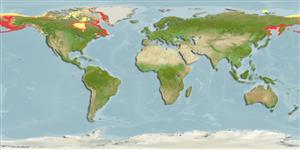>
Perciformes/Zoarcoidei (Eelpouts and pricklebacks) >
Stichaeidae (Pricklebacks) > Stichaeinae
Etymology: Eumesogrammus: Greek, eu = good + Greek, mesos = half + Greek, gramma = signal, mark (Ref. 45335).
Environment: milieu / climate zone / depth range / distribution range
Ecologie
marien benthopelagisch; diepte 5 - 400 m (Ref. 58426). Polar; 82°N - 48°N, 135°E - 43°W
Western Atlantic: Hudson Bay and Ungava to Labrador in Canada and western Greenland. North Pacific: Sea of Okhotsk, Bering Sea and Arctic Alaska (Ref. 6876).
Grootte / Gewicht / Leeftijd
Maturity: Lm ? range ? - ? cm
Max length : 22.0 cm TL mannelijk / geslacht onbekend; (Ref. 7251)
Occurs over sand to gravel-and-stone bottoms at depths of 16-400 meters, typically shallower than 70 meters (Ref. 51666). Benthic; feeds on crustaceans (Ref. 58426).
Levenscyclus en paargedrag
Maturities | Voortplanting | Spawnings | Egg(s) | Fecundities | Larven
Robins, C.R. and G.C. Ray, 1986. A field guide to Atlantic coast fishes of North America. Houghton Mifflin Company, Boston, U.S.A. 354 p. (Ref. 7251)
Status op de Rode Lijst van het IUCN (Ref. 130435)
Gevaar voor de mens
Harmless
Gebruik door de mens
Tools
Speciale rapporten
Download XML
Internetbronnen
Estimates based on models
Preferred temperature (Ref.
123201): -1.6 - 2.1, mean -0.6 °C (based on 1228 cells).
Fylogenetische diversiteitsindex (Ref.
82804): PD
50 = 1.0000 [Uniqueness, from 0.5 = low to 2.0 = high].
Bayesian length-weight: a=0.00417 (0.00203 - 0.00854), b=3.23 (3.05 - 3.41), in cm total length, based on LWR estimates for this species & (Sub)family-body (Ref.
93245).
Trofisch niveau (Ref.
69278): 3.5 ±0.50 se; based on food items.
Weerstandsvermogen (Ref.
120179): Gemiddeld, minimale populatieverdubbelingstijd 1,4-4,4 jaar (Preliminary K or Fecundity.).
Fishing Vulnerability (Ref.
59153): Low vulnerability (12 of 100).
